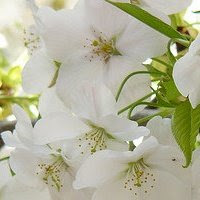|
Japan has four distinc sesons :spring,summer,auntum and winter. Even in Tokyo where everything is so urbanized, seasonal festivals and events add color to peoples’ lives. Why don’t you join in as well and feel the seasons here in Tokyo?
Cherry Blossoms in the Spring
Takoasan-Daihiwatari-sai (The Grand Hi-Watari (fire crossing) Festival of Mt. Takao) is held annually on the second Sunday of March. In it people walk accross fire barefeet, as an act of discipline. Toward the end of March, in the cherry blossoms start to bloom. There are many famous locations for cherry blossom viewing in Tokyo such as Chidorigafuchi and Sumidagawa River. The Sakura Matsuri (Cherry Blossom Festival) is held in Ueno Park and many other places. In May, Kurayami Matsuri (a festival in the dark) is held at Ookunitamajinja Shrine in Fuchu. The float leaving the shrine in the evening on May 5 is famous. In mid May, there is the Kanda Matsuri of Kanda Myojin Shrine and the Sanja Matsuri of Asakusajinja Shrine theat recreate the atmosphere of old Edo for the festival-loving Edo natives.
Fireworks in the Summer
From early July, the Asagao-ichi (morning glory fair) is held in Iriya and many other places. From late July, firework festivals are held everywhere including around the Sumidagawa River and in Jingu-Gaien. In particular, the Tokyo Bay Grand Fiework Festival is a major summer event. The Fukugawa Hachiman Matsuri of Tamioka Hachiman Shrine is also known as the Mizukake Matsuri (festival of water-splashing) because the audience splashes water into the float carriers. The Asakusa Samba Carnival decorates the end of August. Authentic dancers are invited from Brazil to perform at the end of August.
Autumn Leaves
In late September, Ikebukuro becomes a hot spot for festivals. Fukuro Matsuri offers various performances such as dancing, music and giant floats. Ikegami Honmonji Temple’s Oeshiki (Buddhist ceremony) displays 100 sets of spectacular Mando (lanterns). Kibano-Kakunori (log rolling stunts in Kiba) in mid October is a performance by raftsmen hopping on floating timber using just tobiguchi (firefighting spear points) and is designated as an Intangible Cultural Heritage by the Tokyo Metropolitan goverment. On November 3, Tokyo Jidai Matsuri (historical parade) displays picture scrolls dating back to the temple’s foundation in the vicinity of Sensoji Temple. On the day of the Tori (Rooster) of the Chinese calender in mid November, Torino-ichi (open-air market) is held in different places, in which Kumade (bamboo-rakes) are popular as good luck symbols for business success.
Winter’s Night View
On December 14, the Gishi-sai (loyal Retainer Festival) is held at different locations such as Honjo Matsuzaka-Cho Park, which used to be part of Lord Kira’s mansion, and Sengakuji Temple, home to the graves of the loyal 47. From December 17-19, Hagoita-ichi (Ornamental Battledore Fair) is held at Sensoji Temple, In addition to ordinary decoration battledores,artistic battledores like Fujimusume dolls, Samurai named Benkei and battledores representing contemporary topics are displayed for sale. Recomendations for Oshogatu (New Year) re New Year Grand Kabuki and New Year Grand Sumo at Kokugikan stadium. In January, the Izu Oshima Island is known for Ume blossoms (Japanese plum) and there are many Ume festivals in the Tokyo area such as the one in the Yushima Tenmangu shrine in February and another at Yoshino Umeseto in Ohme.
Cherry Blossoms in the Spring
Takoasan-Daihiwatari-sai (The Grand Hi-Watari (fire crossing) Festival of Mt. Takao) is held annually on the second Sunday of March. In it people walk accross fire barefeet, as an act of discipline. Toward the end of March, in the cherry blossoms start to bloom. There are many famous locations for cherry blossom viewing in Tokyo such as Chidorigafuchi and Sumidagawa River. The Sakura Matsuri (Cherry Blossom Festival) is held in Ueno Park and many other places. In May, Kurayami Matsuri (a festival in the dark) is held at Ookunitamajinja Shrine in Fuchu. The float leaving the shrine in the evening on May 5 is famous. In mid May, there is the Kanda Matsuri of Kanda Myojin Shrine and the Sanja Matsuri of Asakusajinja Shrine theat recreate the atmosphere of old Edo for the festival-loving Edo natives.
Fireworks in the Summer
Autumn Leaves
Winter’s Night View







